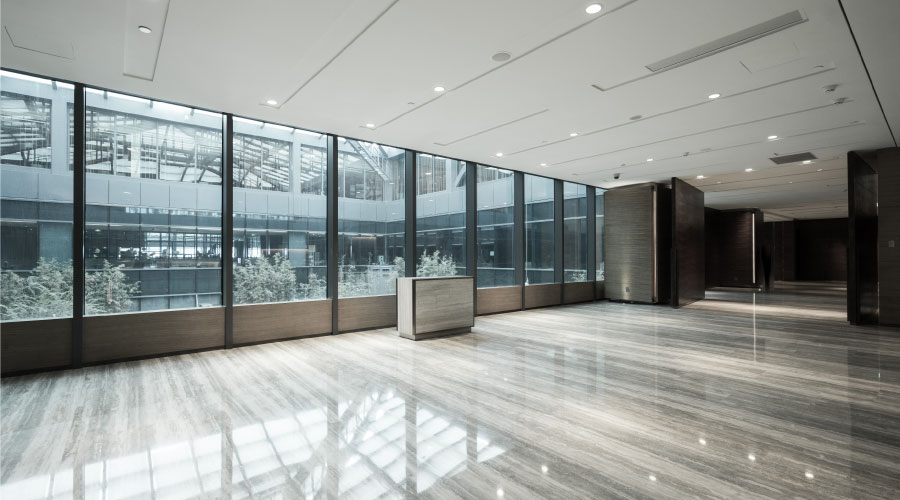Flooring: One Step Ahead
Ensuring that flooring performs as intended means that managers first must understand flooring composition and maintenance needs
By Christopher Capobianco
Resilient flooring has been around for more than 100 years. But during the past 20 years, the flooring industry has gone through numerous changes, and manufacturers have introduced and reintroduced numerous resilient flooring products.
Before specifying a flooring system, maintenance managers need to understand the variety of systems now available and, just as importantly, the maintenance requirements of each.
Types of Flooring
ASTM F141-04, Standard Terminology Relating to Resilient Floor Coverings, defines resilient flooring as an organic floor surfacing material made in sheet or tile form or formed in place as a seamless material of which the wearing surface is non-textile. It includes but is not limited to surfaces made of asphalt, cork, linoleum, rubber, vinyl, vinyl composition, and polymeric-poured floors.
Resilient flooring is not necessarily made of soft material, but it could be any non-textile product that is not stone, ceramic, wood or laminate flooring.
Housekeeping workers can maintain many resilient floors by using conventional methods with floor finishes, buffing and burnishing. Pad selection is especially important. Black and brown pads are aggressive and can damage resilient products. Also, chemicals for vinyl flooring can damage products such as rubber, linoleum and cork.
Managers should consult with a flooring product’s manufacturer regarding care before starting a maintenance program. It is interesting to note some maintenance trends occurring in the flooring industry. For example, some organizations are maintaining high-end resilient products without finishes, instead using an autoscrubber with a red pad for cleaning and a white pad for medium-speed burnishing.
Also, more organizations are using semi-permanent, water-based urethane coatings that eliminate the need for floor finishes or buffing. These are applied much like a finish for a wood floor and are maintained by sweeping and autoscrubbing.
Finally, non-coated methods and urethane coatings can save a great deal of time and money, but only if they are done properly.
Essential for ensuring the long-term performance of all types of resilient flooring is understanding the formulation of these products and their maintenance needs.
Vinyl Composition Tile
Vinyl composition tile (VCT) accounts for more square footage than any other category of resilient flooring. Millions of square feet of this well-known product have been installed in retail stores supermarkets, hospitals, and schools.
Solid Vinyl Tile
Solid vinyl tile (SVT) is different than VCT, although they often are grouped into the vinyl tile category. Managers also might hear the term luxury vinyl tile (LVT) applied to printed film products made to look like wood, stone, concrete and other materials.
But not all LVT products are solid vinyl, and many of them are residential-grade products. As a result, it pays for managers to ask a few questions about LVT products. Make sure to ask the supplier to define its characteristics and maintenance requirements.
SVT can be made with a homogeneous appearance that looks similar to VCT, but the printed-film products make up most of the business today. These products use a photographic print film laminated between a backing and a clear vinyl wear layer. Some SVT products feature extremely realistic designs.
The difference between VCT and SVT is vinyl content. SVT has much more vinyl in it, so it is not as porous. The printed film products are made with a clear vinyl wear layer on top that is highly resistant to staining and soiling.
Workers can maintain SVT floors with conventional finishes formulated for solid vinyl. Sometimes, the top surface is so non-porous that the finish might not adhere well to the floor. If finish-adhesion problems arise, it might be necessary to apply a sealer coat.
Housekeeping workers who plan to use a high-speed burnisher on a printed film product should make sure they have a build up of at least seven coats of floor finish to prevent damage. They also should make sure the floor is flat and has no loose edges. A growing number of organizations are maintaining SVT floors without floor finish or with semi-permanent coatings.
Finally, managers specifying SVT flooring should be aware of PVC-free, non-vinyl and chlorine-free products. They are similar in appearance to SVT flooring, but they are not vinyl. Finishes generally do not adhere to these products.
Linoleum
Linoleum often is confused with sheet vinyl. As sheet vinyl gained popularity compared to natural linoleum in the 1960s and 1970s, the term linoleum continued to be used for all sheet goods, including tile products. Even today, sheet vinyl is regularly called linoleum, and VCT sometimes is called linoleum tile. These products are completely different.
Linoleum is made of linseed oil, pine rosin, ground cork, wood flour, mineral fillers, and pigments, and it is bonded to a jute or synthetic backing. Although the linoleum once was a printed product, manufacturers today sell homogeneous, marbleized linoleum.
During the manufacturing of some linoleum products, the linoleum cures in drying rooms for several weeks, and a yellowish film might develop on the surface of the product. The film disappears after a few hours or days of exposure to light.
Workers should never try to scrub off the yellowish film. Linoleum floors are more sensitive to chemicals and abrasives than vinyl floors. Workers also should not use high-pH strippers or cleaners because strong alkaline cleaners can damage linoleum. Instead, they should use chemicals formulated for linoleum floors.
Sheet Vinyl
Sheet vinyl falls into two categories. Some products are similar to VCT, and others are more similar to vinyl content and even clear wear layers that are maintained like SVT. Managers should ask manufacturers which category defines their sheet- vinyl flooring. Sheet vinyl often is flash-coved up the wall, and these areas need extra care during cleaning. Workers also should inspect floor seams. If they start to open, cleaning the floor might make the problem worse.
Rubber
Institutional and commercial facilities continue to use rubber tile, sheet and stair treads because they are tough, durable and slip-resistant. The surface texture can vary from a smooth marbleized or chip design. Raised designs, including circular, square, hammered or diamond-plate patterns, also are popular with circular, square, hammered or diamond-plate designs.
Workers can clean smooth rubber products with mops or pads, but they should use brushes to clean textured products. Workers might coat rubber floors to increase the product’s gloss, but this process might reduce the floor’s slip-resistant characteristics. A better choice might be to clean and buff the floor, or to use detergents that clean the floor and leave behind a protective, non-buffable film that is waterproof and slip-resistant.
Cork
Similar to rubber and linoleum, cork is an old product that is making a comeback. Although cork is classified as resilient flooring, it acts like wood after installation. As a result, workers should maintain cork floors as they do wood floors.
Managers should identify the type of finish on the floor — polyurethane, wax or oil. Each one requires different maintenance procedures. No matter the type of finish, though, workers should not wet-mop or autoscrub a cork floor because water is the enemy of wood and cork.
Most manufacturers have a technical staff that can answer managers’ questions about these products, and some offer on-site training. To ensure long-term success, managers should take advantage of these opportunities before starting a floor-maintenance program.
Christopher Capobianco is the owner of Flooring Answers — www.FlooringAnswers.com — a national consulting firm that provides training, technical support, troubleshooting, testing and inspection services.
Score One for the Floor
The U.S. Green Building Council (USGBC) recently approved hard-surface flooring products certified by the FloorScore program as an alternative compliance path to achieve credit in the Leadership in Energy and Environmental Design (LEED) rating system for new construction.
The FloorScore program was developed by Scientific Certification Systems, a nationally recognized third-party certification company, and the Resilient Floor Covering Institute. Under the program, hard-surface flooring is tested and certified for compliance with California’s indoor air quality emission requirements. Types of resilient flooring that can carry the FloorScore seal include vinyl, linoleum, laminate flooring, wood flooring, ceramic and rubber flooring.
A flooring product bearing the seal has been independently certified to comply with the volatile organic compound emissions criteria of the California Section 01350 program. Products with the seal have passed a third-party certification process and are recognized as contributing to healthy IAQ.
In a recent credit interpretation ruling, the USGBC approved hard-surface flooring products carrying the seal as an alternative compliance path to LEED credit EQ4.3 Low-Emitting Materials: Carpet Systems. To earn credit, a minimum of 25 percent of a building’s finished floor area — both carpet and non-carpet areas — must be comprised of non-carpet floor products, and FloorScore must certify all of these non-carpet floor products.
USGBC’s draft LEED for Schools rating system document, which is out for public comment, also could give support to FloorScore in its EQ Credit 4.3. If adopted, it would provide LEED credit for low-emitting flooring systems, including hard surface flooring certified under the FloorScore program.
For more information, visit www.rfci.com, or call (301) 340-8580.
— by Dan Hounsell
|
Related Topics:











